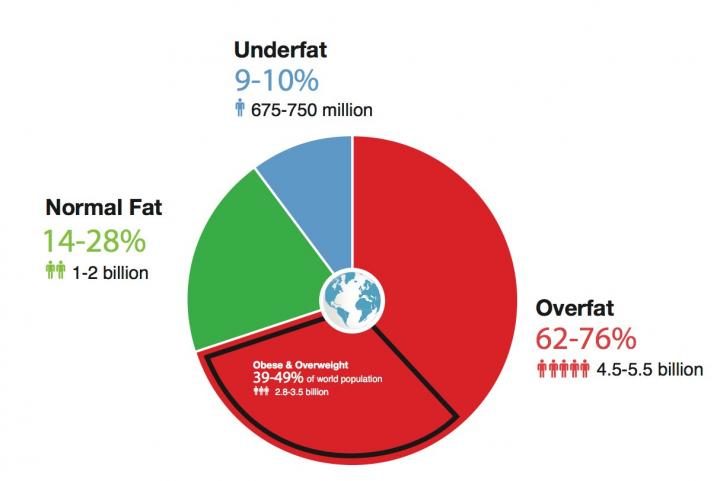"The overfat pandemic has not spared those who exercise or even compete in sports," says lead author of the study Dr. Philip Maffetone, CEO of MAFF Fitness Pty Ltd, who collaborated with Ivan Rivera-Dominguez, research assistant at MAFF and Paul B. Laursen, adjunct professor at the Auckland University of Technology.
The researchers put forth a specific notion of overfat, a condition of having sufficient excess body fat to impair health, in their recent research hypothesis & theory article published in the journal Frontiers in Public Health. Based on a new look into current data, they argue how, in addition to those who are overweight and obese, others falling into the overfat category include normal-weight people.
"The overfat category includes normal-weight people with increased risk factors for chronic disease, such as high abdominal fat, and those with characteristics of a condition called normal-weight metabolic obesity," explains Maffetone.
Comment: According to research conducted by Dr. Robert Lustig, "There are more thin sick people, than fat sick people": Weight isn't an accurate gauge of metabolic health: One-third of slim American adults have pre-diabetes
More than two-thirds of the American population is overweight or obese. About 50 percent have diabetes or pre-diabetes, and 1 out of every 3 have high blood pressure. Many also have high serum triglycerides, which is a risk factor for heart disease and stroke. Insulin resistance is a component of all of these health issues.
According to Lustig, at least 50 percent of Americans have some form of insulin resistance - whether you're overweight or not - and that is what's driving our seemingly out-of-control disease statistics.
About 70 percent of the population is of normal weight, yet about 40 percent of them have insulin resistance upon lab testing, and they manifest aspects of metabolic syndrome as well. They too get type 2 diabetes, hypertension, dyslipidemia, cardiovascular disease, cancer and dementia.
While the obesity epidemic has grown considerably over the last three to four decades, this work casts light on the much higher numbers of people who may have unhealthy levels of body fat.
"We want to bring awareness of the rise in these risk factors, where the terms 'overfat' and 'underfat' describe new body composition states. We hope the terms will enter into common usage, to help create substantive improvements in world health," says Maffetone.
The work also indicates that 9 to 10 percent of the world population may be underfat. "While we think of the condition of underfat as being due to starvation, those worldwide numbers are dropping rapidly. However, an aging population, an increase in chronic disease and a rising number of excessive exercisers or those with anorexia athletica, are adding to the number of non-starving underfat individuals," he explains.
This leaves as little as 14 percent of the world's population with normal body-fat percentage, shows the analysis.
"This is a global concern because of its strong association with rising chronic disease and climbing healthcare costs, affecting people of all ages and incomes," concludes Maffetone.
The study brings to light that new terminology - overfat - is important to replace the old notions of 'overweight' and 'obese'. While it is estimated that up to 49 percent of the world's population, or 3.5 billion people, are obese or overweight, the well-documented obesity epidemic may merely be the tip of the overfat iceberg, state the authors.
The term overfat, as opposed to obesity and overweight, may be more helpful moving forward in addressing this global health problem. "Better, more descriptive terminology tends to have downstream positive effects on the systems and practices that surround the phenomenon."
Summary major points of the work:
- The distinction between 'overweight' and 'overfat.'
- This is the first effort to globally quantify those who are overfat versus overweight or obese.
- The traditional body-mass index (BMI) measures weight and height, but is not a direct measure of body fat.
- Waist circumference may be a more practical solution than the bathroom scale for clinical identification of metabolic health issues.
- Better terminology may lead to better awareness of overfat risks, and help healthcare professionals, public health officials and the public more easily address these problems.




Reader Comments